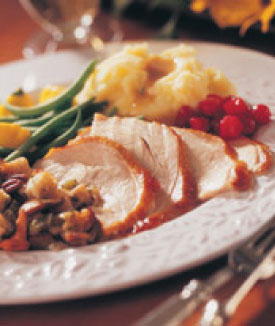Feeling full without being stuffed
by Tom Ballard, R.N., N.D.
This article was originally published in November 2010

The holidays are a time to enjoy delicious meals with friends and family, and from Thanksgiving dinner to office Christmas parties, there are plenty of occasions to indulge. By eating sensible portions, it’s possible to enjoy all your seasonal favorites — mashed potatoes, gingerbread, plum pudding — without feeling more stuffed than the turkey!
It’s no big secret that most people eat too much. Portion size has gotten out of hand. Because of this, obesity, diabetes and heart disease are daily facts of life.
The conventional wisdom around this is the admonition, “Eat smaller portions.” Sometimes this gentle reminder works, but for many people, willpower is not enough. You can ask, threaten or even scream at your stomach all day long, but if your body is still hungry, its message will override your best intentions.
Here’s a simple maxim: Your body doesn’t like starvation — and I’m not talking about calories. If you’re not providing your body with enough protein, essential fatty acids, or other necessary nutrients, it will send you the message to eat more.
Unfortunately your body’s communication system expects you to exercise some common sense. It will not say, “Go eat 22 grams of protein and 10 grams of omega-3 fatty acids and pick up 5 milligrams of B vitamins while you’re at it.” It will simply say, “Go eat” or if you’re very deficient, it will say, “GO EAT! GO EAT! GO EAT!” over and over until you do.
Your messenger system expects you to translate “Go eat” into a nutritious meal or snack. This primitive communication system worked well for millions of years when there were only nutritious, organic, whole foods available to eat.
After you eat nutritionally depraved food, full of calories but without the essential nutrients your body is calling out for, you’ll continue hearing “Go eat.” You might eat thousands of empty calories, distend your stomach, and repulse your liver before the messenger finally becomes too exhausted to ask for more. By the time you’re full, you’ve eaten a day’s worth of calories at one feeding.
Reducing portion size is a critical part of losing weight and gaining wellness. The first step is to “Regularly eat a variety of whole foods.” This will reduce the “Go eat” message that you’re pestered with. It’s not always easy to reduce the size of meals, but if your nutritional needs are being met, then it’s easier.
Remember the importance of regular meals and snacks at regular times throughout the day. A common stumbling block to reducing portion size is waiting too long between meals. If you let yourself become overly hungry the logic of reducing your food intake will be lost under the roar of “Feed me!” You can prevent this problem by supplying your cells with nutritious snacks between meals. Snacks don’t have to be large, only packed with nutrients.
Portion size
The first step in controlling portion size is to start your day with a nutrition-packed breakfast and continue that strategy throughout the day. Once they’ve mastered “Regularly eating a variety of whole foods,” most people find their appetite declines, leading them to eat smaller portions.
Some people do have a difficult time reducing calories, even after switching to a more nutritious eating program. These people often are so used to the emotional satisfaction of large meals that it’s hard to stop. For them, what works is scaling back portion size slowly and deliberately over time. Relishing the looks, smells and tastes of foods helps with tummy satisfaction.
The best way to reduce the size of meals is to cut down on the carbohydrate portion. Try decreasing the carbs (bread) in your sandwiches by using only one slice, or making a “lettuce wrap” instead.
Or, let’s say you’re eating a healthy lunch or dinner, such as steamed vegetables, chicken and rice. This meal is full of nutrients, yet is perhaps more than you need in your sedentary job. To cut the total size and calories of this meal, reduce the rice portion.
It also can be helpful to increase the vegetable portion, since it has few calories and lots of vitamins and minerals. Ask restaurant staff for smaller portions or substitutions — “Can I have twice the vegetables and half the rice?”
Reducing the size of your meals over several weeks will change your appetite and your stomach size. You’ll find you enjoy food more as you consume less of it.
Tom Ballard, R.N., N.D., is founder of Pure Wellness Centers (www.PureWellnessCenters.com). His book, “Nutrition-1-2-3: Three proven diet wisdoms for losing weight, gaining energy, and reversing chronic disease,” is available at PCC stores. Contact him at info@PureWellnessCenters.com.
